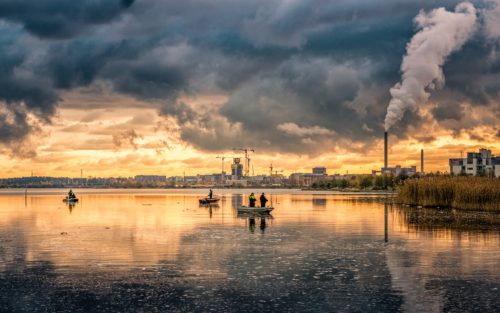
Photo provided courtesy of Unsplash.com
By Daniel Pagana, Staff Writer
Under the current administration, the Environmental Protection Agency (EPA) has repealed and/or weakened almost 100 environmental laws. [1] Recently, the EPA has been focusing on weakening the Clean Water Act by repealing Waters of the United States rule in September of 2019 and repealing Rapanos v. United States, both of which expanded the definition protected bodies of water. [2] [3] Because the current administration has started this trend of rolling back federal environmental laws, the issue has become a major talking point for Democratic presidential candidates and likely will remain on the forefront as the November elections approach. [4]
The international community has also been focusing in on environmental issues, especially after the September 2019 speech passionately given by sixteen-year-old Greta Thunberg, in which famously chastised world leaders for their inaction toward global warming. The speech jumpstarted a youth environmental movement around the world. [5] Despite the movement initiated by Thunberg and the calls of the presidential hopefuls, the Trump administration continues to cut laws away that meet a standard of federal overreach.[6]
New York, the home state of President Trump, has recently been very active in approving new environmental laws. The capstone of New York’s recent environmental law productivity is the creation of the Climate and Community Protection Act (CLCPA). [7] The CLCPA was enacted following the formation of the United States Climate Alliance, of which New York is a member as well. [8] The Alliance was formed on June 1, 2017- the same day that the Trump Administration left the Paris Agreement. [9] In forming this group, New York and other states hoped that the goals of the Paris Agreement to prevent climate change would not be totally forgotten. [10] [11] The regulations in the CLCPA vary from limiting certain types of chemicals from children’s products, to banning plastic bags from all places that collect sales tax, to enacting laws that prohibit the sale of vulnerable species. [12] The main purpose of the CLCPA is to limit statewide emissions with ambitious deadlines; it hopes to eliminate 60% of the amount of emissions measure in 1990 by the 2030 and 15% of these emissions by the year 2050. [13] To achieve its goals, the CLCPA will utilize the Department of Environmental Conservation (DEC) to regulate cars, boilers, and furnaces with enforceable emissions limits. [14] The Act also outlines a plan to increase in renewable sources of energy to achieve the emissions goals. [15] Currently, New York receives about 70% of its power from either nuclear energy or fossil fuels. However, two of the six total nuclear plants closed within the past year. [16] The CLCPA has emphasized the need to expand renewable energy and energy storage through state funded projects. [17]
With its wide reach across different sectors and areas of the environment, the CLCPA does not regulate fuel and emission standards for motor vehicles. This is because fuel emissions standards are exclusively under federal control. Transportation accounts for almost a third of all emissions in New York. [18] With all of the ambitious efforts the CLCPA has taken, there are still areas that only the EPA has jurisdiction over. When tackling a global problem like climate change, it can be quite the uphill battle to enact proper, effective legislation. However, the CLCPA does serve as a national model of how to approach this problem- not because of the new laws that have passed but because of the New York State Climate Action Council that the CLCPA forms. [19] The Council consists of 22 members, twelve of which are heads of state agencies. [20] The inclusion of different agencies shows how much compromise and involvement is needed in order to combat the climate crisis. As a start, the CLCPA lays ground work for other states to look toward in order to combat this crisis that is only worsening with time.
[1] https://www.nytimes.com/2020/01/22/climate/trump-environment-water.html
[2] https://advance.lexis.com/document/?pdmfid=1000516&crid=76a0c5d3-88df-47ac-b76d-72eb86da6264&pddocfullpath=%2Fshared%2Fdocument%2Fnews%2Furn%3AcontentItem%3A5X2H-4BG1-JBH5-W000-00000-00&pddocid=urn%3AcontentItem%3A5X2H-4BG1-JBH5-W000-00000-00&pdcontentcomponentid=465590&pdteaserkey=sr1&pditab=allpods&ecomp=spnqk&earg=sr1&prid=1bcc78f9-64bb-40ac-b8b7-dbd696098b98
[3] https://advance.lexis.com/document/?pdmfid=1000516&crid=9c4f4533-1948-4946-b86e-6d5a37c111e5&pddocfullpath=%2Fshared%2Fdocument%2Fnews%2Furn%3AcontentItem%3A5Y50-V1W1-DY7P-T0NG-00000-00&pddocid=urn%3AcontentItem%3A5Y50-V1W1-DY7P-T0NG-00000-00&pdcontentcomponentid=172244&pdteaserkey=sr2&pditab=allpods&ecomp=spnqk&earg=sr2&prid=1bcc78f9-64bb-40ac-b8b7-dbd696098b98
[4] https://grist.org/article/how-did-the-fate-of-the-planet-fare-at-the-third-democratic-debate/
[5] https://www.npr.org/2019/09/23/763452863/transcript-greta-thunbergs-speech-at-the-u-n-climate-action-summit
[6] https://www.nytimes.com/2020/01/22/climate/trump-environment-water.html
[7] https://advance.lexis.com/document/?pdmfid=1000516&crid=cacc31f2-3aaf-422f-accc-eb2fb783069d&pddocfullpath=%2Fshared%2Fdocument%2Fanalytical-materials%2Furn%3AcontentItem%3A5XWR-Y781-JSRM-62WW-00000-00&pddocid=urn%3AcontentItem%3A5XWR-Y781-JSRM-62WW-00000-00&pdcontentcomponentid=7373&pdteaserkey=sr2&pditab=allpods&ecomp=spnqk&earg=sr2&prid=bdb031dc-6365-49dd-a307-bd4a74e293bf#
[8] Id.
[10] https://advance.lexis.com/document/?pdmfid=1000516&crid=cacc31f2-3aaf-422f-accc-eb2fb783069d&pddocfullpath=%2Fshared%2Fdocument%2Fanalytical-materials%2Furn%3AcontentItem%3A5XWR-Y781-JSRM-62WW-00000-00&pddocid=urn%3AcontentItem%3A5XWR-Y781-JSRM-62WW-00000-00&pdcontentcomponentid=7373&pdteaserkey=sr2&pditab=allpods&ecomp=spnqk&earg=sr2&prid=bdb031dc-6365-49dd-a307-bd4a74e293bf#
[11] Id.
[12] https://www.law.com/newyorklawjournal/2020/01/08/new-york-environmental-legislation-in-2019/?slreturn=20200031235642
[14] https://advance.lexis.com/search?crid=22fab019-b1e6-468d-a255-a31612d98516&pdsearchterms=LNSDUID-ALM-NYLAWJ-20190710NEWCLIMATELAWWILLRESHAPENYSKEYSECTORS&pdbypasscitatordocs=False&pdmfid=1000516&pdisurlapi=true
[16] Id.
[17] https://advance.lexis.com/search?crid=22fab019-b1e6-468d-a255-a31612d98516&pdsearchterms=LNSDUID-ALM-NYLAWJ-20190710NEWCLIMATELAWWILLRESHAPENYSKEYSECTORS&pdbypasscitatordocs=False&pdmfid=1000516&pdisurlapi=true
[19] Id.
[20] Id.